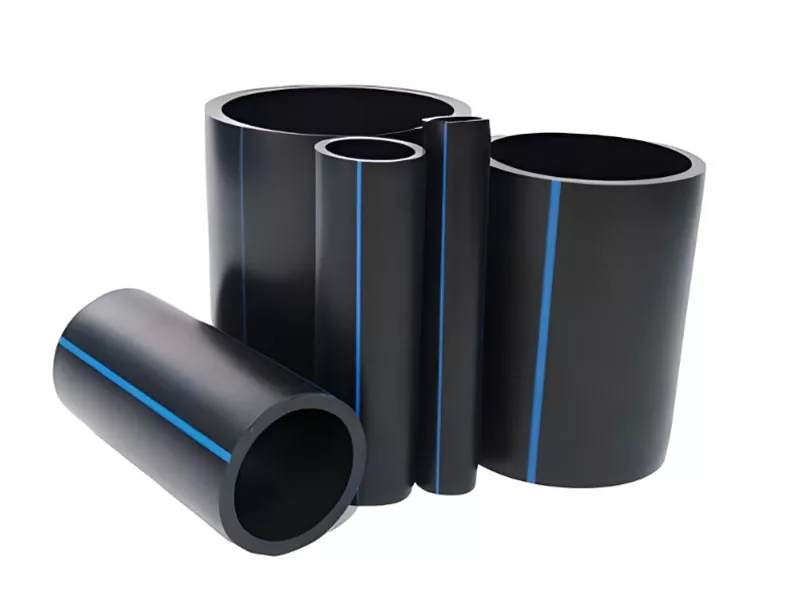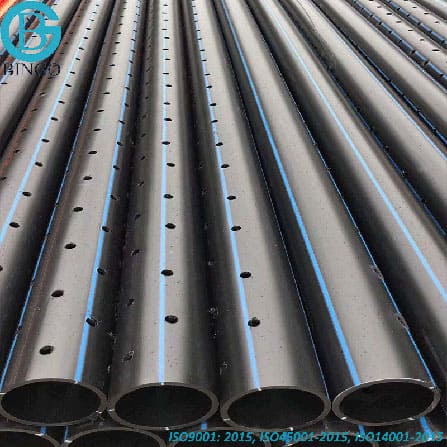The Important Actions for Effective Setup of HDPE Pipeline in Your Following Task
Effective setup of HDPE pipe needs mindful preparation and implementation. Secret steps include evaluating job demands, preparing the site, and selecting correct signing up with techniques. Each phase plays a crucial role in making certain the honesty and efficiency of the pipe. Recognizing these crucial actions can significantly influence the overall success of the project - Pipe Supplier American Plastics Midland. The nuances of each step may hold the key to getting rid of common challenges faced throughout installment.
Comprehending the Benefits of HDPE Pipeline
High-density polyethylene (HDPE) pipeline provides countless benefits that make it a favored selection for various applications. Its high resistance to deterioration and chemicals guarantees resilience sought after settings, considerably expanding the lifespan of setups. In addition, HDPE's flexibility enables less complicated installation, especially in tough terrains, as it can flex without damaging. The light-weight nature of HDPE pipe simplifies transportation and handling, decreasing labor expenses during setup.
In addition, HDPE pipeline is known for its reduced rubbing coefficient, which boosts fluid flow and reduces energy consumption. Its seamless building and construction decreases the danger of leakages, adding to much better resource administration and environmental security. Furthermore, HDPE is recyclable, straightening with sustainable practices and decreasing environmental impact. In general, the mix of toughness, adaptability, and eco-friendliness makes HDPE pipeline a superior selection for a wide variety of projects, from water circulation to industrial applications.
Planning Your HDPE Pipeline Installation
When planning an installation of HDPE pipeline, cautious consideration of numerous vital variables is crucial to protect a successful task. Job managers need to evaluate the specific requirements of the pipe, including the intended use, flow prices, and ecological conditions. Understanding these criteria will lead the option of suitable pipeline dimensions and product grade.
Next off, timelines ought to be developed, factoring in purchase schedules and any kind of potential delays. Control with local authorities for licenses and regulatory compliance is additionally important. Additionally, a thorough budget must be prepared, encompassing all prices connected with products, labor, and equipment.
Last but not least, it is very important to involve a certified team experienced in HDPE pipe setup. Their knowledge will certainly help alleviate threats, guarantee adherence to industry requirements, and eventually contribute to the job's success. Detailed planning lays the groundwork for a smooth setup procedure and lasting efficiency of the HDPE piping system.
Preparing the Website for Setup
Correct website preparation is crucial for the effective installment of HDPE pipeline. Prior to installation begins, the site should be extensively assessed to guarantee it meets all necessary requirements. This includes surveying the ground for existing frameworks, energies, and possible threats that might impede the installment procedure.

Correct elevation and alignment ought to be established to maintain a consistent gradient for water drainage objectives. Correct water drainage around the installment website is likewise imperative to stop water build-up, which can result in issues down the line.
Methods for Joining HDPE Water Lines
Attaining a reliable link in between HDPE pipes is essential for making sure the integrity and long life of the installation. Numerous strategies exist for signing up with these pipes, each fit for different task demands. Fusion welding is just one of one of the most usual approaches, using warmth to bond the pipe finishes with each other, developing a seamless and durable link. This technique can be more categorized into outlet combination and butt fusion, relying on the pipe arrangements.
Mechanical installations are an additional option, using clamps and threaded connectors to sign up with sections of HDPE pipeline. While normally faster to set up, they might call for extra upkeep over time. Electrofusion is a customized method that includes utilizing electrical current to heat and fuse the pipelines through particularly developed installations, guaranteeing a solid bond. Selecting the appropriate signing up with strategy is essential, as it directly influences the general efficiency and integrity of the HDPE piping system in the intended application.
Checking and Inspection of Installed Pipeline
The screening and inspection of installed HDPE pipes are important to guaranteeing their capability and longevity. This process includes aesthetic examination strategies, pressure testing techniques, and leak detection procedures to determine prospective problems. By using these approaches, specialists can validate the honesty of the installment prior to it is placed into usage.
Aesthetic Inspection Techniques
Employing effective aesthetic examination strategies is essential for assuring the honesty of mounted HDPE pipes. Assessors must methodically check out all noticeable sections of the pipeline to recognize any indicators of damages, misalignment, or improper installation. Secret signs to examine include joint honesty, surface area irregularities, and connections. Assessors might use tools such as multiplying glasses or cams to improve visibility and information. It is important to examine for indications of environmental stress and anxiety, such as bending or too much flexing, which could endanger efficiency. Constant paperwork of searchings for permits tracking changes over time and assists guide essential repair services. By adhering to established aesthetic examination procedures, task teams can especially decrease the threat of future failures and assure long-term integrity of the piping system.
Pressure Checking Methods
Aesthetic evaluation works as a preliminary action, yet it is not sufficient on its very own to guarantee the efficiency of installed HDPE pipes. Stress screening methods are crucial for guaranteeing the integrity of these systems. Commonly, hydrostatic testing is utilized, where the pipelines are full of water and based on pressure levels over the desired operating pressure. This technique aids determine weak points or possible leakages. Pneumatic testing can likewise be used, although it lugs better risks due to the compressibility of air. Regardless of the technique chosen, adhering to market standards and safety and security procedures is crucial. After carrying out stress examinations, comprehensive paperwork is needed to confirm the results and confirm that the installation meets all operational requirements prior to continuing to the following stage of the task.

Leak Detection Procedures
How can one assure that set up HDPE pipes are without leaks? Efficient leak detection procedures are vital to protect the integrity of the system. Initially, visual evaluations should be executed, looking for indicators of water accumulation or soil disintegration around pipe joints. Following this, pressure testing can verify the system's stamina. An usual approach is the hydrostatic examination, where water is presented under stress, keeping an eye on for declines that suggest potential leakages. Furthermore, progressed technologies, such as acoustic sensing units or infrared thermography, can find leakages that may not show up. Regular surveillance and maintenance further add to the durability of HDPE pipes, guaranteeing they remain leak-free throughout their functional life-span. Appropriate documents of these procedures is important for conformity and future recommendation.
Upkeep Tips for Long-Term Efficiency
To guarantee the durability of HDPE pipelines, establishing a normal assessment timetable is crucial. This aggressive technique permits the very early discovery of potential problems, lessening costly repairs. Furthermore, executing correct cleansing strategies will help preserve peak efficiency and stop accumulation that can impact functionality.
Normal Inspection Set Up
Although HDPE pipelines are recognized for their longevity and resistance to rust, establishing a routine assessment routine is necessary for guaranteeing their long-lasting performance. Regular examinations aid recognize prospective problems such as leaks, joint honesty, and ecological effects that may affect the pipeline's capability. It is suggested that assessments occur at the very least biannually, or more regularly in settings with extreme conditions. Pipe Supplier American Plastics Midland. During these assessments, visual checks need to be performed to detect indicators of wear or damage. Furthermore, using innovation such as ultrasonic screening can give further understandings right into the pipeline's problem. By implementing a structured examination timetable, project managers can proactively attend to problems, thereby prolonging the life expectancy of HDPE pipelines and preserving system performance
Proper Cleansing Techniques
Correct cleaning methods play an important duty in keeping the long-lasting performance of HDPE pipes. Normal cleaning stops the buildup of particles, debris, and biofilm, which read more can cause clogs and minimized circulation efficiency. Operators must use techniques such as high-pressure water jetting or foam cleansing to effectively eliminate impurities without damaging the pipeline surface area. It is important to avoid using severe chemicals that might degrade HDPE product. Furthermore, arranged maintenance checks must include visual examinations for any kind of indicators of wear or damages. Properly trained personnel should perform these cleaning processes, guaranteeing compliance with safety and environmental policies. By applying these techniques, the life-span of HDPE pipes can be considerably prolonged, making sure ideal efficiency throughout their operational life.
Frequently Asked Questions
What Are the Ecological Impacts of HDPE Pipeline Manufacturing?
The ecological effects of HDPE pipe production include greenhouse gas exhausts, energy intake throughout manufacturing, potential plastic contamination, and difficulties in recycling. However, HDPE's long life and resistance to rust can mitigate some environmental worries.
Just How Does HDPE Pipeline Compare to Other Materials?

What Equipment Are Necessary for HDPE Pipe Setup?
Essential tools for HDPE pipe setup consist of a blend device, pipe cutters, shovels, gauging tape, and safety gear. Proper equipment assurances reliable, secure handling and installment, contributing to the project's overall success and stability.
Exist Any Kind Of Details Rules for HDPE Pipeline Installment?
Details regulations for HDPE pipeline installment differ by region, usually governed by local, state, or government codes. Conformity with these guidelines assurances safety, environmental protection, and functionality, making adherence vital for effective task outcomes.
Can HDPE Pipeline Be Recycled After Use?
Yes, HDPE pipes can be reused after use. Their polycarbonate nature enables for reprocessing, making them suitable for recycling right into brand-new products. This sustainability element adds to ecological preservation and promotes round economic climate methods in building and construction.